Sanskrit › Apsaras and Gandharvas » Ancient origins
Articles and Definitions › Contents
- Sanskrit › Ancient History
- Apsaras and Gandharvas › Ancient History
Ancient civilizations › Historical and archaeological sites
Sanskrit › Ancient History
Definition and Origins
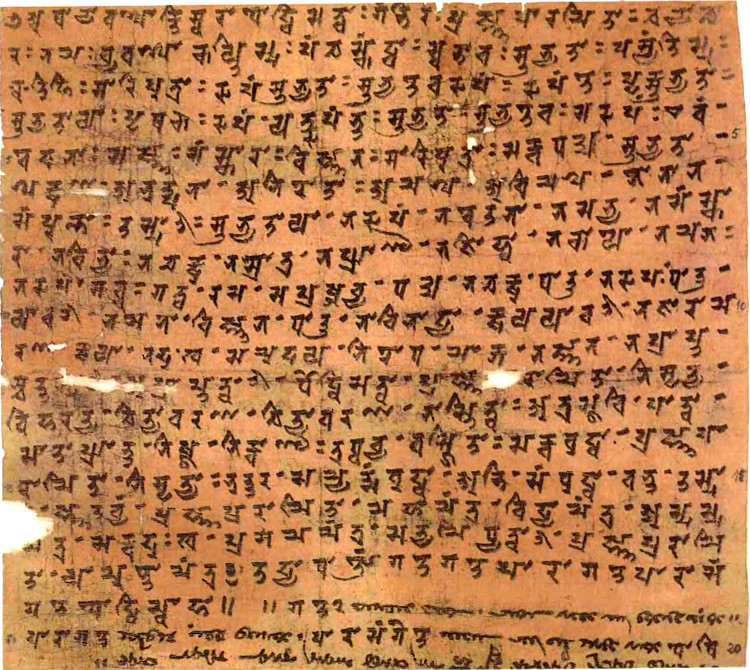
Sanskrit is regarded as the ancient language in Hinduism, where it was used as a means of communication and dialogue by the Hindu Celestial Gods, and then by the Indo-Aryans. Sanskrit is also widely used in Jainism, Buddhism, and Sikhism.The term 'Sanskrit' is derived from the conjoining of the prefix 'Sam' meaning 'samyak' which indicates 'entirely', and 'krit' that indicates 'done'. Thus, the name indicates perfectly or entirely done in terms of communication, reading, hearing, and the use of vocabulary to transcend and express an emotion. An extraordinarily complex language with a vast vocabulary, it is still widely used today in the reading of sacred texts and hymns.
ORIGIN & PURITY OF SANSKRIT
The Sanskrit language was termed as Deva-Vani ('Deva' Gods - 'Vani' language) as it was believed to have been generated by the god Brahma who passed it to the Rishis (sages) living in celestial abodes, who then communicated the same to their earthly disciples from where it spread on earth. The origin of the language in written form is traced back to the 2nd millennium BCE when the Rig Veda, a collection of sacred hymns, is assumed to have been written after being continued for centuries through oral tradition and preservation of verbal knowledge in the Guru-Disciple relationship. The purity of this version (Vedic period, 1500 – 500 BCE) of Sanskrit is doubtlessly reflected in the flamboyance of the perfect description of the forces of nature in the Rig Veda.
VEDIC SANSKRIT
Sanskrit in terms of its literary association is classified into two different periods, the Vedic and Classical. Vedic Sanskrit is found in the Vedas sacred texts, especially the Rig Veda, the Puranas, and the Upanishads, where the most original form of the language was used. The composition of the Vedas is traced to the period of 1000 to 500 BCE, until when Sanskrit had a vigorous tradition of being used consistently through oral communication. This early Sanskrit is rich in vocabulary, phonology, grammar, and syntax, which remains undiluted in its purity to this day. It consists of 52 letters in total, 16 vowels and 36 consonants. These 52 letters have never been tweaked or altered and are believed to have been constant since the beginning, thus making it the most perfect language for word formation and pronunciation.
'TO ACQUIRE THE MASTERY OF THIS LANGUAGE IS ALMOST A LABOUR OF A LIFE; ITS LITERATURE SEEMS EXHAUSTLESS' WCTAYLOR
The Sanskrit language has been the traditional means of communication in Hinduism, Jainism, Buddhism, and Sikhism.Sanskrit literature holds the privilege of being used in ancient poetry, drama, and sciences, as well as religious and philosophical texts. The language is believed to have been generated by observing the natural progression of sounds created in the human mouth, thus considering sound as an important element of language formation. This is one of the prime reasons why Sanskrit has been rich in poetry and its expressive quality of bringing out the best meaning through perfect sounds that are soothing to the human ear. Vedic Sanskrit also contains abstract nouns and philosophical terms which are not to be found in any other language. The consonants and vowels are flexible enough to be grouped together to express nuanced ideas. In all, the language is like an endless ocean without a base due to its reach, complexity, and hundreds of words to express a single meaning or object.
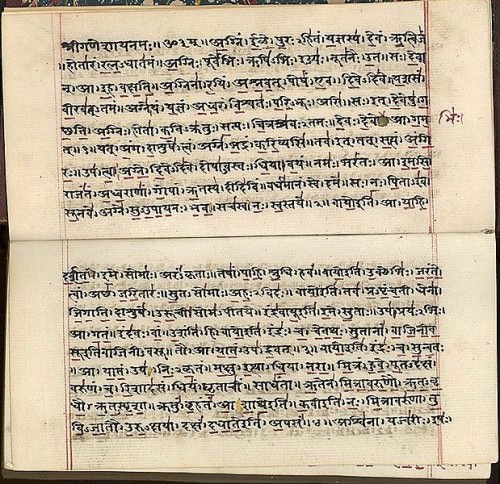
The Vedas (Rig-veda)
CLASSICAL SANSKRIT - ASHTADHYAYI
Classical Sanskrit has its origin in the end of the Vedic period when the Upanishads were the last sacred texts to be written down, after which Panini, a descendant of Pani and a grammar and linguistic researcher, introduced the refined version of the language. Panini's timeline is assumed to be around the 4th century BCE, when he introduced his work 'Ashtadhyayi', which means eight chapters, forming the only available foundational and analytical text of Sanskrit grammar. It is considered to be the only source of Sanskrit grammar and vocabulary today, because everything that existed before had never been recorded except via their mention in Panini's Ashtadhyayi.
The Ashtadhyayi contains 3959 systematised rules that are undiluted in brevity, full of wonderful analysis, explanation, and preferential usage of the language and word formation. The language is so vast that it has more than 250 words to describe rainfall, 67 words to describe water, and 65 words to describe earth, among other descriptions. This proves the magnanimity of Sanskrit when compared with current modern languages. However, different the sub-castes of Hinduism may be in their dialect, race, creed and rank, Sanskrit is considered and accepted as the only sacred language giving rise to the only available sacred literature by all, even though India has a repository of 5000 spoken languages. Panini was responsible for the standardisation of the language, which to this day remains in use in multiple forms. Sanskrit as a spoken language is rare and is spoken in some regions in India, some even claiming it as their first language, but it is proudly mentioned as one of the 14 original languages of India in its Constitution. It is largely used in Carnatic music in the form of bhajans, shlokas, stotras, and kirtanas, all indicating various hymns to the Gods, and songs and mantras of God worship.
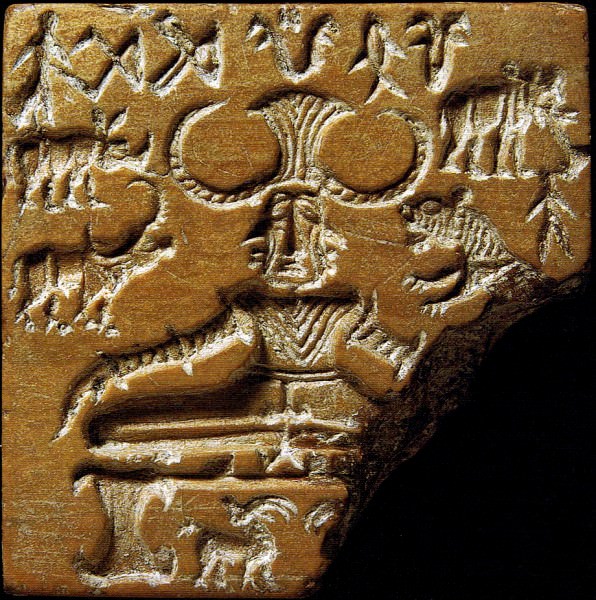
Shiva Pashupati
IMPACT ON OTHER LANGUAGES
Sanskrit has had a major impact on other Indian languages, such as Hindi, which is presently one of the official languages of India, and Indo- Aryan languages such as Kannada and Malayalam. It has impacted the Sino-Tibetan languages with the influence of Buddhist texts in Sanskrit and their translation and spread. Telugu as a language is considered to be highly lexically Sanskrit, from which it has borrowed many words. It has impacted Chinese language as China has picked up multiple but specific words from Sanskrit. In addition, Thailand and Sri Lanka has been enormously influenced by Sanskrit and have many similarly sounding words. The Javanese language is another which has been influenced by Sanskrit, along with the modern language of Indonesia and traditional language of malay spoken in Malaysia. Philippines has a minor influence from Sanskrit, but less than that from Spanish, for example. Above all, English, the current modern international language has also been influenced by Sanskrit and has picked up many loanwords from the ancient language (for example 'primitive' from ' prachin ', meaning historical, 'ambrosia' from ' amaruta ' meaning food of the Gods, 'attack' from ' akramana' meaning taking aggressive action, 'path' from ' patha ' meaning road or way, 'man' from ' manu ' meaning a male human, 'nirvana' from ' nirvan' meaning divine liberation or transcendence, 'door' from 'dwar' meaning a doorway connecting two spaces, ''serpent' from ' sarpa ' meaning snake, etc.) since both are considered as Indo-European languages.
Sanskrit has a long and sacred history often traced back to the Gods and their worship. Starting as a spoken language of the Gods, it has come down to earth and has been diluted of its purity because variable interpretations, precise grammar, and complexity of its use have been accepted by few and avoided by many for its invincibility in vastness and understanding. In spite of its large vocabulary and richness of grammar and prose, many ancient scriptures and texts today are translated from Sanskrit, for none better than Sanskrit can offer such a luxurious literary understanding of the past as it serves as a tool for perfect human expression. Rightfully admired, renowned historian and author William Cooke Taylor acknowledges that “To acquire the mastery of this language is almost a labour of a life; its literature seems exhaustless”.
Apsaras and Gandharvas › Ancient History
Definition and Origins

In the Vedas, the apsaras are water nymphs, often married to the gandharvas. By the time the Puranas and the two epics were composed, the apsaras and gandharvas had become performing artists to the gods; the apsaras are singers, dancers, and courtesans, while the gandharvas are musicians. They are somewhat semi-divine; we do not see them as being able to curse humans (except on one occasion) or grant them boons as gods can, but we do see them as adept in magic and knowledgeable in all of the 64 performing arts; additionally, we see many gandharvas skilled in warfare.
IN THE VEDAS
The oldest conception of the apsaras is as river nymphs, and companions to the gandharvas. They are also seen to live on trees, such as the banyan and the sacred fig, and are entreated to bless wedding processions. Apsaras dance, sing, and play around. They are exceedingly beautiful, and because they can cause mental derangement, they are beings who are to be feared. The Rig Veda mentions one apsara by name; she is Urvasi, wife to Pururava, who is an ancestor of the Kauravas and Pandavas. The story is that Urvasi lived with Pururava, a human king, for a while and then left him to return to her apsara and gandharva companions. The distraught Pururava, while wandering around in a forest, spotted Urvasi playing in a river with her friends, and begged her to return to the palace with him. She refused.
किमेता वाचा कृणवा तवाहं प्राक्रमिषमुषसामग्रियेव । पुरूरवः पुनरस्तं परेहि दुरापना वात इवाहमस्मि ॥
...
न वै स्त्रैणानि सख्यानि सन्ति सालावृकाणां हृदयान्येता ॥
I have moved on from you like the first rays of dawn. Go home, Pururava; I am as hard to catch as the wind.
...
Female friendship does not exist; their hearts are the hearts of jackals. [Rig Veda, 10.95]
The gandharvas are companions to the apsaras. They are handsome, possess brilliant weapons, and wear fragrant clothes.They guard the Soma but do not have the right to drink it. How they lost this right has a story: in one version, the gandharvas failed to guard the Soma properly, resulting in it being stolen. Indra brought back the Soma and, as a punishment for their dereliction of duty, the gandharvas were excluded from the Soma draught. In another version, the gandharvas were the original owners of the Soma. They sold it to the gods in exchange for a goddess - the goddess Vach (speech) - because they are very fond of female company.
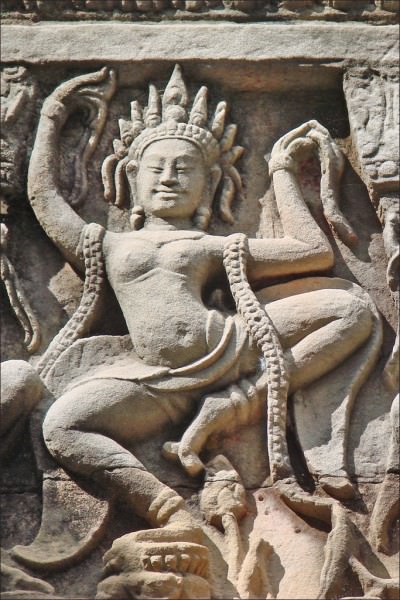
Apsara
Some scholars trace the origin of the gandharvas to the Indo-Iranian period because the Avesta contains references to a similar being (although in the singular, not plural) called Gandarewa who lives in the sea of white Haoma (Soma).
IN LATER LITERATURE
DUE TO THEIR FRIVOLOUS NATURE AS PERFORMING ARTISTS, APSARAS & GANDHARVAS ARE OFTEN CURSED BY SAGES TO BE BORN ON EARTH AS TREES, ANIMALS, OR DEFORMED BEINGS.
In the epics and the Puranas, the apsaras and gandharvas are artistes who perform at the court of Indra and other gods. They are also seen to sing and dance on other happy occasions such as births and weddings of the gods and also of humans particularly favoured by the gods. Additionally, the apsaras are courtesans to the gods and are frequently employed by Indra to distract kings and sages who Indra fears to be progressing along the path of divinity (and hence capable of depriving Indra of his throne). The Kuru-Pandava teacher Drona was born because his father lost control on seeing an apsara; the famous queen Shakuntala was born of an apsara whom Indra sent to seduce the great sage Vishwamitra (Shakuntala's son Bharat was an ancestor of the Kuru-Pandavas; the country, India, is named after Bharat). An apsara called Tilottama was specially created from the essence of all that is good in all the objects of the universe ( til = particle, uttam = best, tilottama = she of the best of all materials) to distract two demon brothers who were causing major grief to the gods; the brothers fought over her and, in the duel, killed each other.
The gandharvas are musicians par excellence. When Arjuna, the third Pandava, went to the heavens in search of celestial weapons, the gandharvas at Indra's court taught him singing and dancing. The gandharvas are good warriors as well. The Kuru prince and heir apparent, Chitrangad, was killed in a battle by a gandharva of the same name. Another gandharva gave an enchanted war chariot and some divine weapons to Arjuna, and on another occasion, imprisoned Duryodhana and his whole pleasure camp when the two groups entered into a dispute over the rights to a picnic spot.
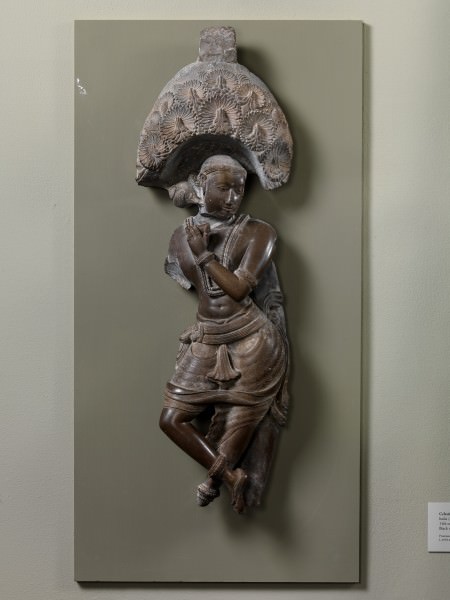
Gandharva
Perhaps because of their somewhat frivolous nature, both apsaras and gandharvas frequently run afoul of the more staid sages and are cursed by them to be born on earth as trees, animals, or deformed beings, redeemable after thousands of years by the touch or grace of an incarnate god or a human hero.
IN MODERN TIMES
The word apsara is used in Hindi, and other similar languages descended from the Indo-European, to generally denote an exceedingly beautiful woman or a talented dancer.
LICENSE:
Article based on information obtained from these sources:with permission from the Website Ancient History Encyclopedia
Content is available under License Creative Commons: Attribution-NonCommercial-ShareAlike 3.0 Unported. CC-BY-NC-SA License